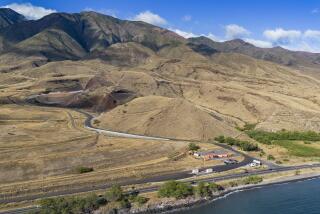It’s your dirty campsite calling
The tone of the voicemail message made me wince. I had just spent two days camping at Lakes Basin Campground north of Lake Tahoe. As always, I had tidied up before leaving: I had put trash in the dumpster, burned matches and scrap paper in the fire pit and stacked my leftover wood neatly for the next campers.
But checking my phone messages a few hours later, while on the road, I was shocked to hear an irate campground host admonish me for leaving the site in “unacceptable” condition.
I mentally retraced my steps. What had happened to the paper I thought I’d burned? The answer, my friend, is blowing in the wind. Just like the extra newspaper I left as kindling for the next campers.
Nobody can prevent wind from scattering paper left in a fire pit, and it’s rare to get chewed out for a sloppy campsite. But nobody wants to pull into a site filled with the mess left by previous campers.
Even in well-used, established campgrounds -- which some land managers refer to as “hardened” sites -- it’s possible to practice minimum-impact or “leave no trace” camping. Following these guidelines isn’t just common courtesy; it also protects the land and ensures the safety of fellow campers.
Whether in the mountains, in the desert or on the coast, leaving a heavy footprint can have a big impact. In Anza-Borrego Desert State Park, where drivers can camp anywhere along 500 miles of road, scars on rocks used to make a fire ring “don’t heal,” says Brian Cahill, the parks information officer. He recommends making campfires in metal containers -- portable barbecues, even washtubs.
Meadows are “especially fragile because they’re wet and have an amazing diversity of life,” says Matt Mathes, spokesman for the U.S. Forest Service’s Pacific Southwest Region.
To protect untrod land, avoid cutting new paths to the bathroom or between campsites, and stick to established routes, advises Lee Anne Schramel Taylor, an information officer at Plumas National Forest north of Lake Tahoe. It’s also forbidden to move fallen logs or rocks without returning them to their original locations. Taylor knows of campers who’ve roped boulders to their pickup trucks to rearrange campsites. Not acceptable.
In Yosemite National Park, leaving food or trash out is a matter of life or death -- for a bear. Bears are easily attracted to sites with food scraps, says park ranger Adrienne Freeman. Yosemite Valley campers get a thorough education in keeping a neat camp to prevent bear visits when they check in and also during daily walk-throughs by rangers.
“Leaving food and trash is likely to attract an animal, and attracting animals is a sure way to harm them,” says Freeman. Problem bears are sometimes killed by park or game officials, hence the saying, “A fed bear is a dead bear.” Rangers often confiscate unattended coolers, which act as dinner bells for wily bears.
Even little things can build up over time and cause problems on public lands. The sheer number of outdoor enthusiasts is starting to have an effect as some sites become overused, says Dana Watts, executive director of the Leave No Trace Center in Boulder, Colo., a nonprofit organization that promotes low-impact outdoor recreation nationwide.
“We’re trying to encourage people to take things into their own hands, to keep areas as natural and wild as they can for future generations,” says Watts.
The group preaches seven leave-no-trace principles, some of which apply mostly to backpacking but can be applied to car camping. One of the most important things on the list: Plan ahead and prepare, which means finding out ahead of time whether, for example, campfires and/or wood gathering are allowed at a particular campground. This way you’ll know whether to pack a stove or pick up a bundle of wood.
In Yosemite Valley, collecting wood isn’t allowed. “People think it’s silly, but the point is lots of animals use that wood for shelter, and minerals from wood go back in the soil, maintaining a healthier ecosystem,” says Freeman, who adds that it’s not acceptable to nail things like clotheslines to trees.
Keeping a clean camp also helps ensure the safety of subsequent campers, who may not welcome visits from Mr. Bear, a creature with an indelible memory of the s’more that fell to the ground two days ago. And making sure fires are properly extinguished is of utmost importance.
When setting up camp, pick sites that have been used and make sure high-impact tent and kitchen areas are on durable surfaces such as dirt or hard ground.
The challenge of leaving no trace may be easier for car campers than backpackers. Mostly it’s using common sense and having respect for the land and others. “Public lands are a gift,” says Mathes. “They literally belong to everyone, and the public has the responsibility to keep [them] in as good shape as possible.”
Keeping a clean campsite is a cost-cutting measure. Leaving a mess means hiring more staff to clean up, which could mean higher camping fees. Clean campsites also mean happy campground hosts -- which I now understand, firsthand.
*
To e-mail Julie Sheer or read her previous columns, go to latimes.com/juliesheer.
*
Camping by the numbers
Here are the seven leave-no-trace principles to keep in mind when creating a home in the outdoors.
1. Plan ahead and prepare. For example, know the rules of where you’ll be camping. Poor planning and unexpected conditions can degrade backcountry areas.
2. Travel and camp on established surfaces, such as trails and campsites, rock, gravel, dry grasses or snow. Camp at least 200 feet from lakes and streams.
3. Dispose of waste properly. Inspect campsites for trash or spilled foods.
4. Leave what you find. Rocks, plants and other natural objects should remain as you find them.
5. Minimize campfire impacts. Use established fire rings or pans or mound fires, and keep them small.
6. Respect wildlife. Never feed wild animals; it damages their health, alters natural behaviors and exposes them to predators and other dangers.
7. Be considerate of other visitors.
Source: Leave No Trace Center for Outdoor Ethics
More to Read
Sign up for The Wild
We’ll help you find the best places to hike, bike and run, as well as the perfect silent spots for meditation and yoga.
You may occasionally receive promotional content from the Los Angeles Times.






